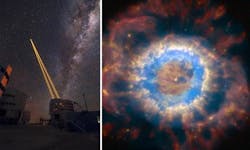ESO's Adaptive Optics Facility for the Very Large Telescope sees first light
With four telescopes each with an 8.2-m-diameter primary mirror, the Very Large Telescope (VLT), located at Cerro Paranal, Chile, is the flagship facility of the European Southern Observatory (ESO; Garching bei München, Germany). The four telescopes can be combined into an interferometer to resolve objects much smaller than can be resolved by the individual telescopes.
Now, the Unit Telescope 4 (Yepun) of the VLT has been transformed into a fully adaptive telescope. After more than a decade of planning, construction and testing, the new Adaptive Optics Facility (AOF) has seen first light with the telescope's Multi Unit Spectroscopic Explorer (MUSE), capturing very sharp views of planetary nebulae and galaxies. MUSE is an integral-field spectrograph, an instrument that produces a 3D data set of a target object, where each pixel of the image corresponds to a spectrum of the light from the object. The coupling of the AOF and MUSE forms one of the most advanced and powerful technological systems ever built for ground-based astronomy.
The AOF is a long-term project on the VLT to provide an adaptive-optics (AO) system for the instruments on Unit Telescope 4 (UT4). The AO systems compensates for the blurring effect of the Earth's atmosphere, enabling MUSE to obtain sharper images and resulting in twice the contrast previously achievable. MUSE can now study fainter objects in the Universe.
AOF produces dramatic improvements in sharpness
Following a battery of tests on the new system, the team of astronomers and engineers were rewarded with a series of spectacular images. Astronomers were able to observe the planetary nebulae IC 4406, located in the constellation Lupus (The Wolf), and NGC 6369, located in the constellation Ophiuchus (The Serpent Bearer). The MUSE observations using the AOF showed dramatic improvements in the sharpness of the images, revealing never before seen shell structures in IC 4406.
The AOF is composed of many parts working together. They include the Four Laser Guide Star Facility (4LGSF) and the very thin deformable secondary mirror of UT4. At just over 1 m in diameter, this is the largest AO mirror ever produced and demanded cutting-edge technology. It was mounted on UT4 in 2016 to replace the telescope’s original conventional secondary mirror. The 4LGSF aims four 22 W laser beams into the sky to excite sodium atoms in the upper atmosphere, producing spots of light on the sky that mimic stars. Sensors in the AO module GALACSI (Ground Atmospheric Layer Adaptive Corrector for Spectroscopic Imaging) use these artificial guide stars to determine the atmospheric conditions.
(For more on the 4LGSF, see http://www.laserfocusworld.com/articles/2016/04/eso-s-four-laser-guide-star-facility-sees-first-light.html. Note that in the Laser Focus World article, the term "first light" was used only to denote the first tryout of the AO system itself, as opposed to the true "first light" that is the topic of this new ESO announcement.)
At a rate of 1 kHz, the AOF system calculates the correction that must be applied to change the shape of the telescope's deformable secondary mirror to compensate for atmospheric disturbances. In particular, GALACSI corrects for the turbulence in the layer of atmosphere up to one kilometer above the telescope. Depending on the conditions, atmospheric turbulence can vary with altitude, but studies have shown that the majority of atmospheric disturbance occurs in this ground layer of the atmosphere.
Narrow-field mode to debut in 2018
GALACSI currently provides a correction over a wide field of view, but this is only the first step in bringing adaptive optics to MUSE. A second mode of GALACSI is in preparation and is expected to see first light early 2018. This narrow-field mode will correct for turbulence at any altitude, allowing observations of smaller fields of view to be made with even higher resolution.
One of the main science goals of the system is to observe faint objects in the distant Universe with the best possible image quality, which will require exposures of many hours. "In particular, we are interested in observing the smallest, faintest galaxies at the largest distances," says Joël Vernet, ESO MUSE and GALACSI project scientist. "These are galaxies in the making—still in their infancy—and are key to understanding how galaxies form."
MUSE is not the only instrument that will benefit from the AOF. In the near future, another AO system called GRAAL (GRound layer Adaptive optics Assisted by Lasers) will come online with the existing infrared instrument HAWK-I, sharpening its view of the Universe. That will be followed later by the new instrument ERIS (Enhanced Resolution Imager and Spectrograph).

John Wallace | Senior Technical Editor (1998-2022)
John Wallace was with Laser Focus World for nearly 25 years, retiring in late June 2022. He obtained a bachelor's degree in mechanical engineering and physics at Rutgers University and a master's in optical engineering at the University of Rochester. Before becoming an editor, John worked as an engineer at RCA, Exxon, Eastman Kodak, and GCA Corporation.
